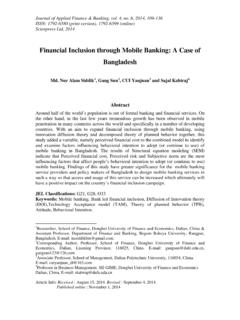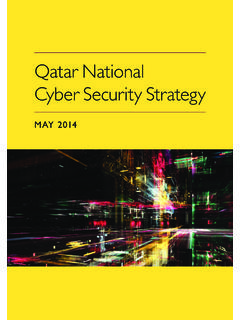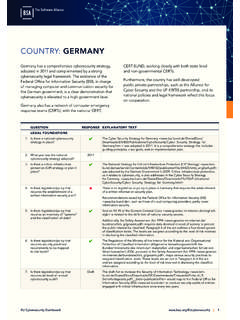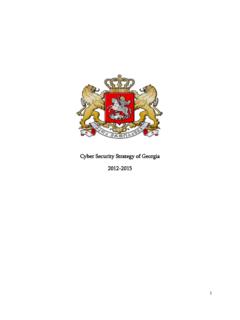Transcription of Challenges and Objectives for the National Cyber-Security ...
1 Journal of Computations & Modelling, , , 2014, 1-10 ISSN: 1792-7625 (print), 1792-8850 (online) Scienpress Ltd, 2014 Challenges and Objectives for the National Cyber-Security strategy Beyond 2020 Col. Dimitrios Choupis, Phd, GRC A1 Abstract. While the prediction of cyberspace future landscape is quite difficult, Greece must seek to define the potential threats and understand the forces that are formulating the National , regional but also the global future of Cyberspace in order to modulate influence and adapt to these changes. As we look toward 2020 and beyond, it is crystal clear that there are significant Challenges , issues and functions that might need to be taken under consideration. However, in order Greece to form an effective cyber defense strategy , a significant number of future Challenges need, to be taken into account.
2 Till now independent practical steps and incoherent cyber defense initiatives are under implementation. The majority of NATO nations but also a significant number of non-NATO nations developed their own National strategies in order to establish an efficient and effective response mechanism and roadmap for the future. The answer for Greece to all these future requirements, is a comprehensive mid-term strategic framework, through which the nation will guide its activities and will react to all changes and advances in technology, in order to actively meet both the threats and opportunities. Greece requires an early warning-early response cyber defense strategy in order to articulate the framework to 2020. The goal must be to keep technological efficiency and effectiveness in close cooperation and coordination with our allies and other critical stakeholders, in order the nation to be able to respond faster than vulnerabilities and threats will be exploited.
3 Through this roadmap Greece will meet its vision for a safe, secure and resilient cyberspace and will establish a strong foundation for all efforts in the future full of Challenges complex cyberspace environment. Keywords: Cybersecurity, strategy , cyber -defense, cyber space, cyber terrorism 1 Hellenic Army Staff E-mail: 2 Challenges and Objectives for the Cyber-Security 1 Introduction Greece has already recognized the significance of the cyber threats that face the country mainly since the cyber attacks on Estonia in 2007. Afterwards, Greece has began establishing a limited number of initiatives in order to improve National ability to prevent, deter, defend against and recover cyber attacks, which are rapidly evolving both in frequency and sophistication.
4 Despite these initiatives there is no relative National policy on cyber Defense which provides a solid foundation from which all relevant National stakeholders can take work forward on cyber security . Following this roadmap, the nation improved its ability to defend its own networks but there is no implementation of a coordinated approach to cyber defense that encompasses planning Objectives and capability development aspects for nation s own structures and nation s local authorities and public sector s services, in a coherent response mechanism in the event of a cyber attack. As we look toward 2020 and beyond, it is crystal clear that there are significant Challenges , issues and functions that might need to be taken under consideration in close coordination with our allies.
5 However, the answer to these future requirements, is a comprehensive mid-term strategic framework, through which the nation will guide its activities and will react to all changes and advances in technology, in order to actively meet both the threats and opportunities. 2 NATO and EU cyber Defense Policy and Action Plan Overview NATO On 8 Jun 2011, NATO Defense Ministers approved a revised NATO policy on cyber Defense, in order to provide a solid foundation methodology which Allies can take work forward on cyber security . The document itself clarifies NATO s priorities and NATO s efforts in cyber defense, including which networks to protect and the way this can be achieved. The document is coupled with an implementation tool (an Action Plan) which represents a detailed living document (continuously updated), with specific tasks and activities.
6 Through this framework, NATO will ensure that it is at the forefront of developments in cyber space and maintains the proper flexibility to meet the issues and Challenges posed by cyber threats. More briefly, NATO s D. Choupis 3 cyber Defense Policy set out the What and cyber Defense Action Plan details the How it will be achieved. All NATO structures ([1]), including NATO s agencies and bodies abroad, will be under centralized protection. New cyber defense minimum military requirements will be applied, either in National networks that are connected to NATO or process NATO information, in order to meet the objective for a secure infrastructure. Additionally, this policy will integrate cyber defense considerations into NATO structures and planning procedures.
7 Moreover, it will focus on prevention, resilience and defense of critical cyber assets of NATO and Allies. Last but not least, NATO will provide, if needed, coordinated assistance for an ally or allies to achieve the minimum level of requirements for cyber defense and also to reduce vulnerabilities of their National critical infrastructures, including a situation in which they are victims of a cyber attack. Principle cyber defense initiatives and a significant number of practical steps are under implementation. In a multilevel approach, different NATO organizational elements, bodies and committees are responsible for implementation of the planning of capabilities and assisting Allies. It is indicative, that a NATO Computer Incident Response Capability (NCIR) will be established by the end of 2012, including the dispatch of a Rapid Reaction Team (RRT) ([2]), in a role of NATO s cyber warriors.
8 Moreover, NATO s Cooperative cyber Defense Centre of Excellence (CCDCoE) ([3]) in close cooperation with Allies, is encouraged to provide expertise, support and research and training, also in parallel with NATO s existing schools. European Union European Union is in close cooperation with NATO, with regards all the cyberdefence initiatives in order to establish a comprehensive approach also in this crucial area. Research and innovation for cyber defence and combating cyber -crime is an issue that concerns the European Defence Agency (EDA), the European Commission, and the European Space Agency (ESA) and all similar EU organizational entities. Many of the underlying technologies are the same for civil and military applications so this subject is also a crucial initiative for ESDP also.
9 Consequently, a certain degree of coordination between civil and defence research is 4 Challenges and Objectives for the Cyber-Security under implementation and a significant number of projects are also on the execution phase also. Last but not least many joint workshops to shape the research and innovation agenda in the areas of cyber defence and the fight against cyber -crime and terrorism was therefore organized. 3 Greece Moving Towards 2020 cyber Space Challenges While the prediction of cyberspace future landscape is quite difficult, Greece must seek to define the potential threats and understand the forces that are formulating the National future of Cyberspace in order to lead influence and adapt to these changes. However, in order for Greece to form an effective cyber defense strategy , a significant number of future Challenges need, to be taken into account.
10 These Challenges are outlined below: The aggregation of data in National and more generic global network cloud computing ([4]), combined with remote and distributed management, will create additional security Challenges and will complicate today s traditional techniques. It is indicative that this network cloud, more or less, will be an internet of things and the threat actors could probably use highly available on-line tools to hack key infrastructure in this cloud-based computing operational environment. The on-line user based concept, also in nation s cloud network, will expand in order to include many and smart mobile platforms and devices, capable of using the web exchanging (collaboration), or transfer sensitive classified information without the need of intervention (virtualization).



















